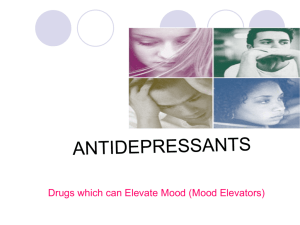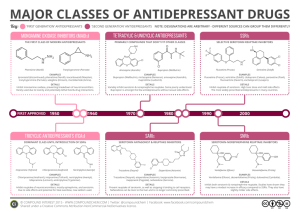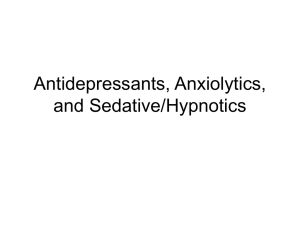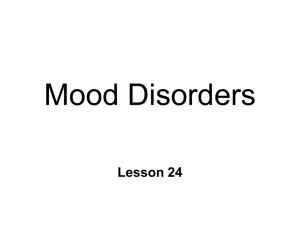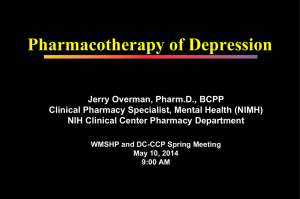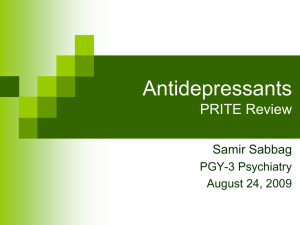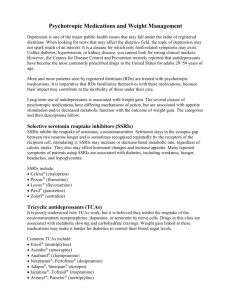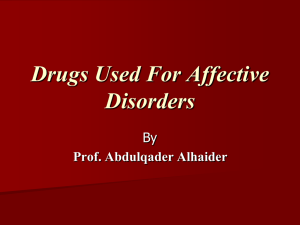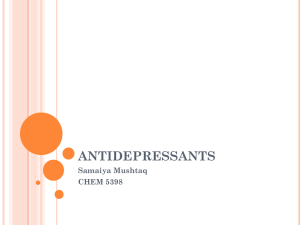Lecture 7 - printable Antidepressants old and new 11
advertisement
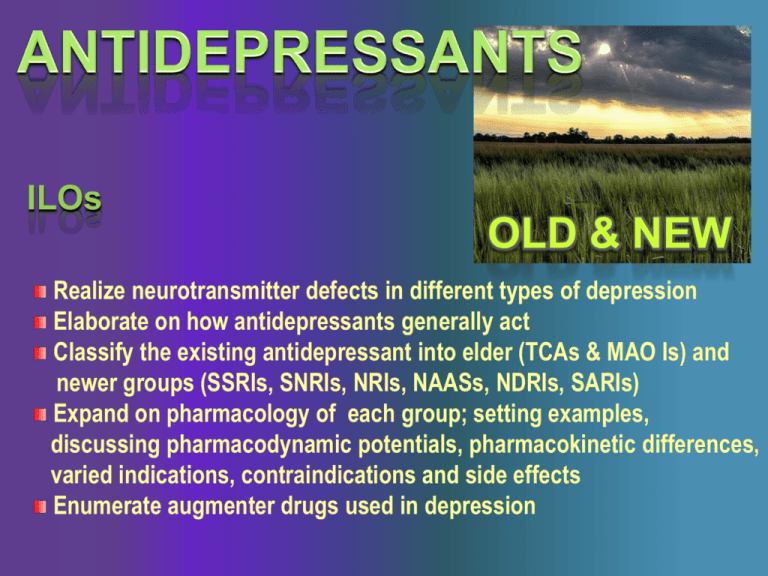
ILOs OLD & NEW Realize neurotransmitter defects in different types of depression Elaborate on how antidepressants generally act Classify the existing antidepressant into elder (TCAs & MAO Is) and newer groups (SSRIs, SNRIs, NRIs, NAASs, NDRIs, SARIs) Expand on pharmacology of each group; setting examples, discussing pharmacodynamic potentials, pharmacokinetic differences, varied indications, contraindications and side effects Enumerate augmenter drugs used in depression The concept of action of all drugs relay on extracellular biogenic amines in the brain indirectly by blocking their catabolism or directly by preventing their uptake + altering receptor firing. All drugs take weeks to manifest their clinical effect [to control depressive manifestations], even though their pharmacological actions starts immediately indicating that secondary adaptive changes must occur before the benefit is gained The delay presentstime needed for inhibitory somatodendritic autoregulatory 5HT1A receptors or axonal autoregulatory 5HT1D to be sensitized [down regulated] to permit more synthesis & release of transmitter at synaptic cleft with enhanced signaling at postsynaptically serotonergic & adrenergic > (b) neurones → therapeutic effect. Treatment should continue 6 months at full therapeutic doses before withdrawal. Withdrawal of drugs must be very gradual otherwise withdrawal symptoms Agitation Worsening of the disease Withdrawal manifestation They mediate therapeutic effects MONOAMINE OXIDASE INHIBITORS MAO is a mitochondrial enzyme found in nearly all tissues Two forms of monoamine oxidase exist: MAO-A responsible for NE, 5-HT catabolism. It also metabolizes tyramine of ingested food MAO-B is more selective for dopamine metabolism MONOAMINE OXIDASE INHIBITORS Non Selective Inhibitors (MAO-A & MAO-B) Irreversible Phenelzine, long acting [persists 2w after stop] Reversible Tranylcypromine, [persists 7 days after stop] Selective Reversible Inhibitors Moclobemide, (MAO-A) Selegiline, (MAO-B) Seldom used now because; ADR, Food & Drug Interactions Low antidepressant efficacy = Low benefit/risk ratio; All are well absorbed, metabolized & excreted in urine MAOIs activity of MAO preventing monamine break down availability indirectly Possess both a Adrenoceptor & mAch blocking effects Indications MAOIs now only reserved in atypical depression and depression resistant to other therapy In treatment of social anxiety (agrophobia) ADRs 1. Antimuscarinic effects. 2- Postural hypotension. 3- Sexual dysfunction mainly with phenelzine. 4- Sedation , sleep disturbance. 5- Weight gain 6- Hepatotoxicity ( phenelzine) Food interactions Many foods containing tyramine are normally degraded in the gut by MAO-A MAOIs inhibit this process tyramine is absorbed taken up into adrenergic neurons converted into a false transmitter replaces NE in vesicles & when massively released results in hypertensive crisis. Distribution of 5-HT2 So avoid foods rich in receptors Tyramine ; Aged cheese, liver, sausages, fish , some meat & yeast extracts. Levodopa ; Broad beans, FAVA beans. Drug interactions 1. If with (indirect acting sympathmimetic, flue medications, local anesthetics & TCA) severe hypertension hypertensive crisis 2- If with SSRI fatal serotonin syndrome [hyperthermia, muscle rigidity, cardiovascular collapse ] so keep 6 weeks space between their use 3- If with pethidine inhibition of metabolism ↑ its levels leads to hyperpyrexia, irritability, hypotension and coma. Distribution of 5HT2 receptors TRICYCLIC ANTIDEPRESSANTS 1st Generation Tricyclic Antidepressants have three-ring nucleus structure Tertiary amines Secondary amines Block 5HT& NE reuptake More side effects More selective to NE Less side effects Imipramine (Tofranil) Amitriptyline (Elavil) Desipramine (Norpramin) Nortriptyline (Pamelor) + Block ADR (α1), Histamine (H1) & Ach (M1)receptors. + block adrenergic (α1), histamine (H1) & muscarinic (M1)receptors. Pharmacokinetics Given once daily Some of them give active metabolites Imipramine Desipramine Amitriptyline Nortriptyline Clinical Indications Used for long duration without loss of 1- Treatment of depression; effectiveness [preferable to MAOIs] Elevate mood Improve mental alertness. Increase physical activity - With lithium in depressed phase of bipolar depression - In resistant depression if other therapy fail - With antipsychotics in depressed psychotic patients. 2-Other psychiatric disorders; Obsessive-compulsive disorders (OCD) (OCD; DA & NE in the brain's prefrontal cortex.) Generalized anxiety disorders Panic disorders Anorexia nervosa 3-Other disorders; Control bed-wetting in children; Imipramine contraction of internal sphincter of bladder . Better desmopressin Gradually withdrawn / Treatment period do not exceed 3 months. Neuropathic pain; better Tertiary amines > modulate endorphins Give in smaller doses than that prescribed for depression. Prophylaxis of migraine ADRs Anti-cholinergic: Dry mouth, blurred vision, constipation & urine retention, aggravation of glaucoma Anti-histaminic: Sedation, confusion. Stop sedatives 1-2 w before use Anti-adrenergic (>α) C.V.S ; Postural hypotension, arrhythmias conduction defects ( prolonged Q-T interval - heart block ) Weight gain, sexual dysfunction & impotence Lower seizure threshold Aggravation of psychosis EARLY IN USE During 1st month aggravate suicidal thoughts specially in young aged. Can happen less upon change of dose. DURING USE narrow therapeutic index toxicity can develop Excitement, delirium , convulsions, respiratory depression , coma, atropine like- effects, cardiac arrhythmias, sudden death. DIALYSIS STOPAGE OF USE Withdrawal Symptoms; characterized by cholinergic rebound, flu-like symptoms. Interactions Being strongly bound to plasma proteins toxicity enhanced by aspirin, phenylbutazone, ….etc Being metabolized by hepatic microsomal enzymes toxicity enhanced by enzyme inhibitors. With MAOIs, SSRIs or any sympathomimetic drugs cause hypertensive crisis Additive to sedatives or other CNS depressants respiration Additive to antipsychotics & anti parkinsonisms anticholinergic effects. Glaucoma Heart disease Liver disease Seizure disorder Contraindications Thyroid disease Prostate hypertrophy Pheochromocytoma Chronic bronchitis Serotonin Norepinephrine Reuptake Inhibitors (SNRIs) Fluoxetine Fluvoxamine Citalopram Sertraline Paroxetine Venalafaxine Norepinephrine Reuptake Inhibitors (NRIs) Reboxetine Selective Serotonin Reuptake Inhibitors SSRIs Noradrenergic & Specific Serotonergic Antidepressants (NaSSAs) Mirtazapine Norepinephrine Dopamine Reuptake Inhibitors (NDRIs) Bupropion Serotonin Antagonists & Reuptake Inhibitors (SARIs) Trazodone Nefazodone SSRIs Fluoxetine Fluvoxamine Citalopram Sertraline Paroxetine Binds to SERT 5-HT levels in synapse No effect on NET No block to mAch, H, or a1 Adrenoceptor so no antimuscarinic nor sedative effects They are nearly of comparable efficacy but of preferential response in each individual Pharmacokinetics t1/2 : Too long (3-11 days): Fluoxetine (Prozac) Moderate length (~24hr): Sertraline, Paroxetine, Citalopram. Metabolism: P450 then conjugation They are enzyme inhibitors Weak inhibitors < Sertraline, Citalopram interaction Strong inhibitors > Fluoxetine, Paroxetine metabolism of TCA, neuroleptic, some antiarrhythmic, β-blockers. Primarily excreted through kidney; not paroxetine & sertraline undergo partially fecal excretion. Fluoxetine differs from others members of this class in : 1- It has a longer t1/2 (50hrs). 2- Available as sustained release preparations once weekly. 3- Metabolite norfluoxetine = potent as parent drug t1/2 10 days. Clinical Indications First choice for most depression. Comparable efficacy as TCAs but much safer < sedation & antimuscarinic side effects < toxicity in over doses Fluoxetine is approved in children, adolescence, elderly males with prostatic hypertrophy & relatively safe in pregnancy. Used in: Anxiety and panic disorders Obsessive-compulsive disorders Some eating disorders (bulimia) Pain associated with diabetic neuropathy Premature ejaculation Premenstrual syndrome. Alcohol abuse. Anorexia nervosa. Generalized anxiety disorder (GAD). ADRs Insomnia, anxiety, agitation, nervousness > fluoxetine > citalopram useful in fatigued patients Sedation & lassitude > paroxetine, sertraline useful in patients with difficult sleep . GIT upset ( nausea, vomiting, diarrhea) (indirect stimulation of 5-HT3 receptors in the enteric nervous system ) Anorexia & weight loss Impotence & sexual dysfunction; loss libido, delayed ejaculation (Indirect CNS stimulation of 5-HT2) useful in patients who have premature ejaculation. Mild CV & minimal antimuscarinc side effects unlike TCAs Withdrawal manifestation < intensity than TCAs Interactions Serotonin Syndrome if combined with MAOIs > other ADDs [Autonomic instability (changes in BP, pulse, hyperthermia), muscle rigidity, respiratory depression, mental confusion, shivering, sweating and diarrhea ] Enzyme inhibitors metabolism = toxicity of TCA, neuroleptic, some antiarrhythmic, β-blockers. Reuptake Inhibitors & Mixed Action Novel ADDs Serotonin Norepinephrine Reuptake Inhibitors [ SNRIs ] Venalafaxine Restore the levels of NE & 5HT in the synaptic cleft by binding to NET & SERT Has mild antimuscarinic effect Short t1/2 HR & BP Side effects similar to SSRI drugs but may be withdrawal manifestations on discontinuation may need dosage tapering Norepinephrine Reuptake Inhibitors [ NRIs ] Reboxetine Block only NET No affinity for 5HT, DA, ADR, H, mAch receptors So, has positive effects on the concentration and motivation in particular. Safe to combine with SSRIs Minimal side effects only related to activation of ADR system as tremor, tachycardia, and urinary hesitancy Noradrenergic & Specific Serotonergic Antidepressants [ NaSSAs ] Mirtazapine Blocks presynaptic a2 adrenoceptors + 5HT3 > 5HT2 receptors Preferred in cancer patients because: 1. Improves appetite 2- nausea & vomiting ( 5-HT3 blocking) 3- body weight 4- Sedation (potent antihistaminic) 5- Less sexual dysfunction (5-HT2 blocking) 6- Has no anti-muscarinic effect . Side effects; drowsiness, appetite, and weight gain. Norepinephrine Dopamine Reuptake Inhibitors (NDRIs) Bupropion Is unique in possessing significant potency as NE and DA reuptake inhibitor, with no direct action on 5HT. Acts as a nAch antagonist Therapeutic uses: 1- Treatment of major depression and bipolar depression. 2- Can be used for smoking cessation. As it reduces the severity of nicotine craving & withdrawal symptoms Advantages: No sexual dysfunction given in young No weight gain [ No 5HT effect ] No orthostatic hypotension. Side effects: Seizures; it threshold of neuronal firing Serotonin Antagonists & Reuptake Inhibitors (SARIs) Trazodone Psychtropic drug Weak block of SERT > NET Block 5-HT2 α- blocking effect ( hypotension) Potent H1- blocker( sedation ) High protein bound Extensive hepatic metab Urine excretion Cause priapism (a antagonisim ) Arrythmogenic Nafazodone Trazodone is its precursor No No Inhibit Cyt450 Hepatic failure Augmenter drugs Some antidepressants work better in some patients when used in combination with another drug. This "augmenter" drugs include: Buspirone Antipsychotics; typical or atypical Lithium; is used to augment ADDs in resistant unipolar depression Trazadone, Nafazodone, Bupropion are sometimes included among augmenters but there use as such should be under strict clinical supervision Antidepressants & Sedation Sedating ADDs are; Amitryptyline, Paroxiteine, Sertraline, Mirtazapine, Trazadone, So better given near bed time Less Sedating ADDs are; Bupropion, Venalafoxine , MOA Is, So can be given in the morning as some cause insomnia as side effect. Antidepressants and appetite??? DA is responsible for eating. 5HT action on 5HT2 halts dopamine release so suppress appetite. Depression is accompanied more by weight loss. SSRIs by ↑ 5HT availability to act on 5HT2 could suppress appetite. At least no weight gain with SSRIs. Most TCAs have dual reuptake inhibition + sedation + antihistaminic effects ↑ weight gain Mirtazepine blocks 5HT2 so cannot shut off dopamine signals ↑ weight gain N.B. Antidepressants isn't always a direct cause to cause alteration in weight. Other contributing factors to weight gain during antidepressant therapy are for example: ↑ day time sleep, ↑ craving for food when mood alleviates, Nausa & Vomiting by SSRIs ↑ 5HT availability act on 5HT3 nausea & vomiting Antidepressants safe combinations; Bupropion + Desipramine SSRIs + Mertazepine, Reboxetine or any other NRIs / SNRIs/ Antidepressant approved for use in children; fluoxetine Antidepressants good for elderly are SSRIs because they can be used at lower dosage giving least side effects in this age group SSRIs use is more than TCAs because they are better tolerated by patients Antidepressants dangerous combinations; MAO Is + SSRIs Serotonin syndrome Paroxetine / Fluoxetine / Nefazodone / + Desipramine, Nortryptiline severe sedation or > toxicity Enuresis Imipramine Chronic pain TCAs (Tertiary better than 2ndry amines ) Duloxetine SSRIs not effective Bulimia Fluoxetine Obsessive convulsive disorder SSRIs Cancer associated depression Mirtazapine Depression in Adolescence and young adults Bupropion
